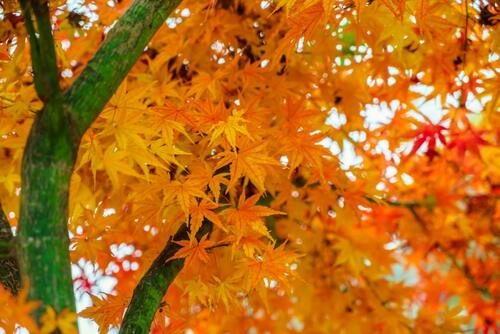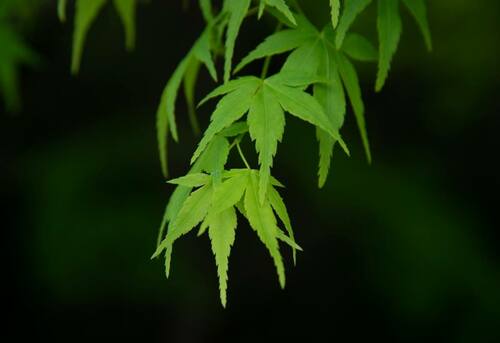Understanding Verticillium Wilt Disease in Japanese Maple Trees
Introduction
Japanese maple trees ( Acer palmatum ) are beloved for their delicate foliage and graceful appearance. However, like any other plant, they are susceptible to various diseases, including Verticillium Wilt . This fungal disease can cause significant damage if not properly managed. Below, we will dive into what Verticillium Wilt is, how to identify it and, most importantly, how to manage, treat, and prevent it to keep your Japanese maple trees healthy and thriving.
What is Verticillium Wilt?

A Japanese Maple Tree with Orange Leaves – Image by jannoon028 on Freepik
Verticillium Wilt is a fungal disease caused by soil-borne pathogens belonging to the Verticillium genus. These pathogens can last in the soil for many years without a host and can infect a wide range of plants, especially including Japanese maple trees. The fungus invades the roots of the tree, blocking water flow and causing wilting, leaf scorch, and, in severe cases, death. The resting structures that the fungus resides in within the soil, or “ microsclerotia ,” can also function as spores that have the ability to spread through soil, infected roots, and even some kinds of infected fruit.
Identifying Verticillium Wilt in Japanese Maple Trees

Green Japanese Maple Leaves – Photo by Norikio Yamamoto on Unsplash
Symptoms of Verticillium Wilt can be categorized as either acute or chronic. Trees with acute symptoms will start showing signs of infection on individual branches or only in a certain part of the canopy and are usually most obvious from late summer into fall—usually after periods of hot, dry weather. Trees with chronic symptoms will usually show a more general decline, identified by signs such as sparse canopies with off-colored leaves, poor growth, and dying branches. The death of the plant can be either slow or sudden depending on the health of the plant as well as the extent of the infection.
Here are some symptoms that can help identify Verticillium Wilt in your tree:
- Leaf Symptoms: Leaves on affected branches may wilt and turn yellow or brown, often starting from one side of the tree. The leaves may also take on a “scorched” appearance in some cases, showing early coloration and falling earlier than normal.
- Branch Dieback: Sections of the tree may start to die back, with leaves becoming sparse or dropping prematurely.
- Vascular Discoloration: Cutting into an affected branch may reveal dark streaks or discoloration in the wood (particularly green in maples) indicating fungal infection. This symptom is a reliable feature to use when diagnosing your tree.
Managing Verticillium Wilt
Once a tree is infected, there are no ways to effectively treat this disease. However, through proper management via preventative measures and practices, you may be able to prolong the life of your tree:
- Prune Infected Branches : Removing and disposing of infected branches can prevent the spread of the fungus.
- Sterilize Tools: Disinfecting pruning tools between cuts can also prevent further contamination by the fungus.
- Improve Soil Drainage: Ensuring proper soil drainage can reduce favorable conditions for fungal growth.
- Avoid Stress: Keep trees healthy by watering regularly , providing sufficient nutrients, and avoiding unnecessary stressors.
- Minimize Root Injuries: Minimizing the chance of root injury by mulching and avoiding gardening under the tree can help decrease chances of infection.
- Distance from Infected Areas: Do not move soil from areas of infection or use wood chips from infected trees; Verticillium fungus can live in the soil for up to 10 years.
Treating Verticillium Wilt
Unfortunately, once a tree is infected with Verticillium Wilt, it is incredibly hard to treat. This is due to the fact that there is no fungicide treatment for this disease.
Ultimately, the best way to control Verticillium Wilt is by taking measures to prolong the life of your tree as outlined above, such as proper pruning of infected branches, watering (especially during dry seasons), and fertilizing the tree if needed with a fertilizer that is low in nitrogen and high in potassium. However, make sure not to overfertilize the tree; excessive fertilization may increase problems with this disease.
Preventing Verticillium Wilt

A Flowering Japanese Maple Branch – Photo by Lana
Preventing Verticillium Wilt involves proactive measures to create an unfavorable environment for fungal growth:
- Plant Resistant Varieties: Choose Japanese maple varieties known to be less susceptible to Verticillium Wilt.
- Rotate Crops: Avoid planting susceptible species in the same location year after year.
- Monitor Soil Health: Regularly test soil pH and nutrient levels to maintain optimal conditions for tree growth.
- Practice Good Sanitation: Clean tools, pots, and other gardening equipment to prevent the spread of fungal spores.
By understanding Verticillium Wilt and implementing preventive strategies, you can protect your cherished Japanese maple trees from this destructive disease. If you suspect Verticillium Wilt in your trees, consult with a professional arborist for an accurate diagnosis and tailored treatment options. With care and vigilance, you can enjoy the beauty of Japanese maple trees for years to come.


